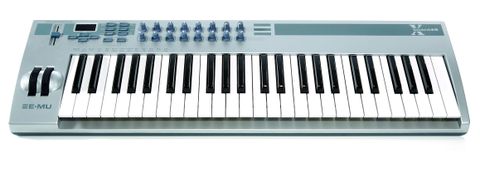There's certainly no shortage of controller-laden MIDI keyboards on the market.
However, E-MU - who are renowned for their expertise in many other areas of music technology - were undeterred and waded in with the Xboard 49. Styled in metallic silver and featuring a blue LED display and rubber controllers, this 49-key keyboard is light and of reasonably sturdy build.
Sixteen rotary controls sit on the top, along with a single slider and several push buttons. Round the back you'll find a USB port, a 1/4" jack footswitch input, a MIDI output, an on/off switch, and a socket for a mains adapter.
You don't get one of these in the box, but the unit can be powered over USB or with three AA batteries. The Xboard driver is easy to install, as is the Xboard Control editing software that's included.
How does it feel?
The 49 velocity-sensitive keys feature aftertouch and are more uniformly mounted than you might expect on a keyboard this reasonably priced.
They're solidly built, and play with an action that's on the heavier side of the semi-weighted spectrum. They offer a good compromise for those people who want some of the weight of a piano but the speed of a synth.
The 16 rotary controls have a good feel to them - they're pleasantly tactile and operate smoothly. However, they're too close together.
This appears to be a case of one-size-fits-all engineering: the panel of rotaries is the same size as the one on the smaller Xboard 25. However, there's much more space on top of the Xboard 49, so it could have been made much wider.
On-keyboard editing is handled by 12 momentary buttons. These are the flimsiest examples we've seen in a long time, pitching and rolling when the lower-octave keys are played. The 16 memory locations can be used to store keyboard setups.
These are edited using the function buttons, with the slider acting as a data entry control. The octave buttons transpose up or down by up to four octaves either way and, when pressed together, send an All Notes Off message (to silence stuck notes).
Elsewhere, the Latch mode is worthy of a quick mention. This enables you to set up a range of keys to operate as triggers - they play continually until they're pressed a second time.
This is particularly useful when you want to trigger loops in a performance environment. Another handy feature is 16 Channel Control Mode. This assigns the same continuous controller value to each of the 16 rotaries, so each one controls that value on the corresponding MIDI channel.
The Xboard 49 has a great set of keys and some genuinely useful features. However, although the rotary controls feel good to use, they're simply too close together - and we're not happy about those flimsy momentary buttons either.
It feels like E-MU cut a couple of corners with this one in order to keep the price down, but the Xboard is a respectable, well-featured controller keyboard nonetheless.


